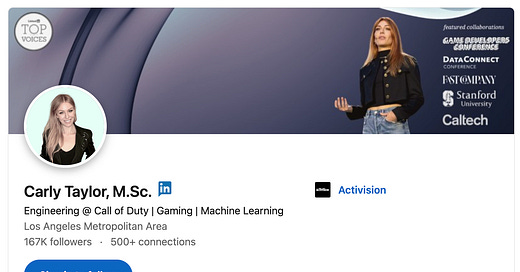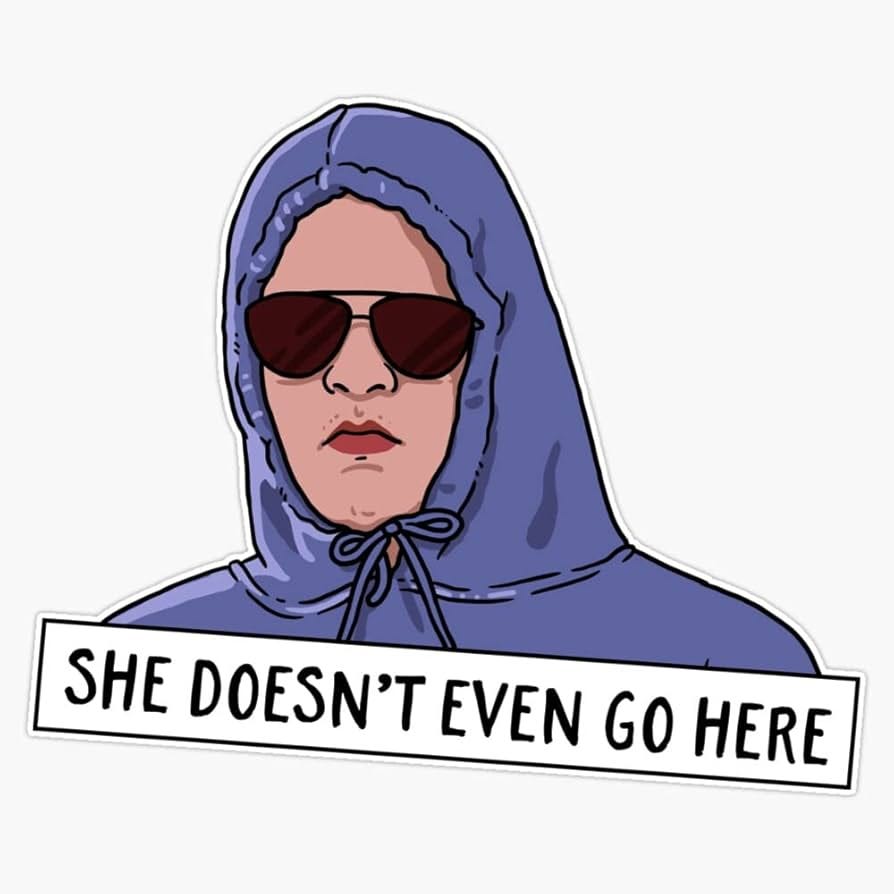This is a 3 part series about expanding your LinkedIn network:
Building Your Foundational Network (Find the Right People & Get Them to Accept Your Requests) ← You Are Here
Engaging With Your Network (How to Build Relationships Beyond the ‘Add Connection’ Button)
Expanding Your Network Through Content Creation (Attract New Connections Without Cold Outreach)
Why LinkedIn Matters
LinkedIn has evolved beyond networking into a storytelling, thought leadership, and authentic connection platform.
Is it full of cringey humblebragging try-hards? Absolutely. I mean, just look at my banner above. It’s like playing influencer BINGO.
Photo of me on stage? ✅
Random mention of Stanford (“she doesn’t even go here!”)? ✅
Top Voice badge? ✅
Gag.
But it is undoubtedly the best place to build your professional brand and network globally. So, hate it or love it, LinkedIn is here to stay.
How to use LinkedIn to your Benefit
I recently posted about who you’re competing against when you apply for a job in tech, and ended it with some (admittedly) tired advice on the best way to land a job:
Keep your volume of applications high, your skills sharp, and continue expanding your network
And while I don’t find this advice particularly ground-breaking, building your network is still the best way to future-proof your career.
So let’s dive into the best ways to actually expand your LinkedIn network.
Part 1: Building Your Foundational Network
1. Finding the Right People to Connect With
Your network is like any other relationship - you can’t expect reliability without a solid foundation. So before you start sending connection requests, you need to be intentional about who you’re adding to your network. The goal of this section is to help you identify people who will provide value, help you grow in your industry, and eventually engage with your content.
But don’t send any connection requests just yet! We are merely identifying valuable people who you might want in your network in this section.
Where to Find the Right People
🔍 Use LinkedIn’s Advanced Search
Search for people using job titles, industries, and shared connections
Prioritize 2nd-degree connections (people who know someone you know), since they’re more likely to accept your request
👥 Find Active People in Comment Sections
Follow industry leaders and influencers in your field
Look at who is commenting on their posts - these are the people actively engaging, meaning they’ll likely interact with you too
🏢 Use the ‘People’ Tab on Company Pages
Want to network into a company? Go to their LinkedIn page and click ‘People’
Filter by department or job title to find employees in your target role or industry
2. How to Send Connection Requests That Actually Get Accepted
A connection request is your first impression so you need to make it personal to avoid sounding like a spammy sales pitch. Let’s take a look at a few connection requests so we understand how they appear to the person you’re connecting with:
Here is someone who is connected to 10 other people in my network:
I may or may not accept this request without a message based on how close I am to those 10 other people. If they’re strangers or just acquaintances, I likely won’t accept.
Here is what a connection request with a custom message looks like:
You can see that only a few characters are shown in the preview, so you need to make the hook of your message strong.
Here is what the message looks like expanded:
You can see this person customized their connection request to me by referencing some content I wrote. You can also see that LinkedIn indicates whether this person is currently following me. I would take both of these things into account when deciding whether or not to accept this request.
Regarding Content Creators
LinkedIn members can have up to 30,000 1st-degree connections. LinkedIn offers this advice on connecting:
To ensure an optimal experience on LinkedIn, we recommend: Connect with people you know personally and trust professionally. Follow anyone whose posts you want to keep up with, so you always stay informed.
So larger content creators might not connect with you because 1. they are at the limit of connection requests or 2. they would rather you utilize the “follow” functionality.
Crafting your Connection Message
What NOT to do:
❌ Send the Default Request – “I’d like to add you to my professional network.” (Nobody accepts this.)
❌ Use Generic Messages – “Hey, I’d love to connect.” (Why? No context.)
❌ Pitch Immediately – “Hi, I’d love to tell you about my product/service/ask for a favor.” (Instant decline. Connecting isn’t the same as networking so let the relationship build naturally.)
What TO Do (Based on How You Found Them):
📌 If You Have a Mutual Connection:
"Hey [Name], I saw we both know [Mutual Connection]—I really admire their work, and I’d love to connect with more folks in [industry]. Looking forward to staying in touch!"
📌 If You Found Them Through a Post or Comment:
"Hey [Name], I saw your comment on [Person’s Post] about [Topic]—totally agree with your take! Would love to connect and follow more of your insights."
📌 If You’re Trying to Break Into a Field:
"Hey [Name], I’m transitioning into [field] and have been following experts like you to learn more. No pressure to connect, but I’d love to follow your work!"
📌 If You’re Reaching Out to Someone in a Company You Want to Work For:
"Hey [Name], I’m interested in [company] and saw that you’ve been there for [X years]. I’d love to connect and hear about your experience when you have time!"
A note on emails/InMail:
If you want to re-ignite a dialog with someone who is already a connection, you can simply send them a message. Connections can see roughly the first 2 lines of your email as a preview.
Conversely, if you want to send an email to someone who isn’t a connection (I don’t recommend this, but y’all are gonna do it anyway so I might as well tell you about it 😂), you’ll be using LinkedIn’s paid InMail feature. InMails can be used to contact second and third-degree connections without sending a connection request. InMail only shows the subject line of your email to people, so it better be good.
3. Optimize Your Profile So People Accept Your Requests
Even if you send the perfect connection request, people won’t accept it if your profile looks half-baked or untrustworthy. Here’s how to fix that:
✅ Have a Strong Headline
Please stop saying “Aspiring [x]” as your headline. It’s giving “what I want to be when I grow up” and it’s not enticing for networking. Instead focus on the value you bring to your network:
“Helping SaaS Startups Scale | Content & Growth Marketing”
“Turning Data into Stories | Analytics & Visualization”
✅ Write a Skimmable ‘About’ Section
People should understand who you are, what you do, and how you can help in 30 seconds or less
Format like this:
What you do – "I help B2B companies grow through SEO and LinkedIn content."
Why you do it – "Passionate about making complex topics accessible through storytelling."
How people can engage with you – "I share insights on growth marketing and personal branding—let’s connect!"
✅ Upload a Decent Profile Picture and Banner
People are 10x more likely to accept a request from someone with a professional-looking profile photo
A clear headshot works best
Avoid selfies, blurry images, or awkwardly cropped group photos
For banners, don’t use your company’s branding unless you are a founder or c-suite executive. Why? Because you’re giving them free advertising and entangling your brand with theirs. And don’t use the LinkedIn default banners. They’re boring. Instead get a free version of Canva and check out their templates:
For Content Creators & Thought Leaders focused on personal branding
You can show your niche or tagline → "I help SaaS startups grow through content & LinkedIn strategy”, or add a call to action (“Follow for insights on AI & tech”)
For Professionals & Job Seekers focused on establishing industry authority
Use an on-brand background (tech? Use a minimal digital theme. Finance? Use a clean, corporate look like a cityscape.)
Add a short phrase that describes your work ("Driving Innovation in AI & Machine Learning")
For Founders focused on representing their company
If you run a business, use your company’s logo, tagline, or key message
I hope that was helpful! Next post will focus on how to engage with your newly-found network. As always, share if this resonated with you and recommend Good at Business to your friends, family, and enemies.
✌️ Carly











Carly, this is incredibly helpful—I appreciate you sharing your insights as a glimpse into what you offer. Thanks for taking the time!
Rex
Hello, it's nice connecting with you, I'm very excited to learn from your experiences ❤️